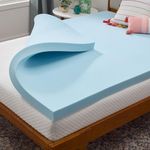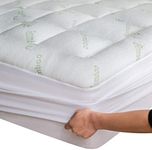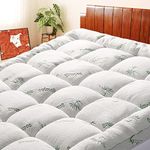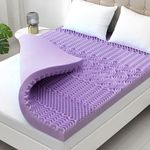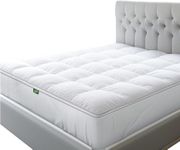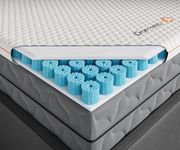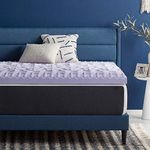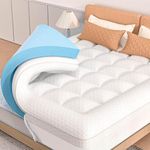Buying Guide for the Best Bed Toppers
Choosing the right bed topper can make a big difference in your sleep quality and comfort. Bed toppers are designed to add an extra layer of cushioning or support to your mattress, helping to address issues like firmness, sagging, or temperature regulation. When shopping for a bed topper, it's important to consider your personal sleep preferences, any specific discomforts you want to address, and the characteristics of your existing mattress. Understanding the key features will help you find a topper that best suits your needs and enhances your overall sleep experience.MaterialThe material of a bed topper determines its feel, support, and durability. Common materials include memory foam, latex, feather/down, and fiberfill. Memory foam offers contouring and pressure relief, making it good for people with joint pain or those who like a hugging feel. Latex is more responsive and breathable, suitable for those who want a bit of bounce and cooler sleep. Feather and down toppers provide a plush, soft surface but may lack support, while fiberfill is a hypoallergenic alternative that mimics down. To choose the right material, think about whether you prefer softness or firmness, need extra support, or have allergies.
ThicknessThickness refers to how tall the topper is, usually ranging from 1 to 4 inches. Thinner toppers (1-2 inches) add a slight comfort boost and are best if you just want a bit more softness. Medium thickness (2-3 inches) can provide a noticeable change in feel and support, suitable for most people looking to improve their mattress. Thicker toppers (3-4 inches) offer the most cushioning and are ideal if your mattress is very firm or you need significant pressure relief. Your choice should depend on how much you want to change the feel of your mattress and your body weight—heavier individuals may benefit from thicker toppers.
FirmnessFirmness describes how soft or hard the topper feels. Soft toppers add plushness and are good for side sleepers or those who want to sink in. Medium toppers balance comfort and support, making them suitable for most sleeping positions. Firm toppers provide extra support and are best for back or stomach sleepers, or those with back pain. Consider your sleeping position and whether you want to soften a hard mattress or add support to a soft one when deciding on firmness.
Temperature RegulationTemperature regulation is about how well the topper manages heat and keeps you cool during sleep. Some materials, like memory foam, can trap heat, while others, like latex or gel-infused foams, are designed to stay cooler. Feather and fiberfill toppers tend to be more breathable. If you tend to sleep hot, look for toppers with cooling features or breathable materials. If you get cold easily, a topper that retains warmth might be better for you.
Allergy ConsiderationsAllergy considerations are important if you have sensitivities to dust mites, feathers, or certain materials. Hypoallergenic toppers, often made from synthetic fibers or latex, are designed to resist allergens and are easier to keep clean. If you have allergies, look for toppers labeled as hypoallergenic and consider how easy they are to wash or maintain.
Ease of CleaningEase of cleaning refers to how simple it is to keep the topper fresh and hygienic. Some toppers come with removable, washable covers, while others can only be spot-cleaned. If you have allergies, pets, or expect spills, a topper with a washable cover is a practical choice. Think about your lifestyle and how much effort you want to put into maintenance when making your decision.
